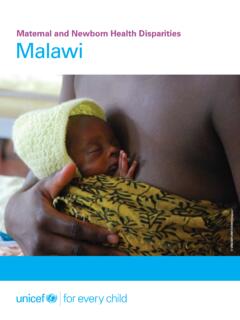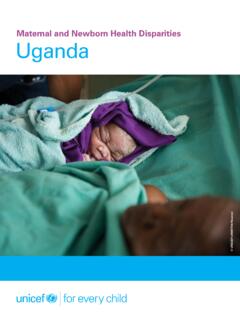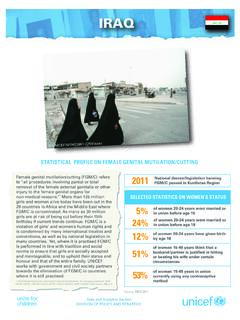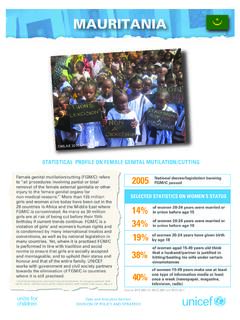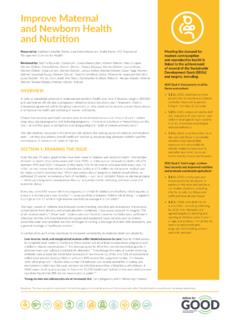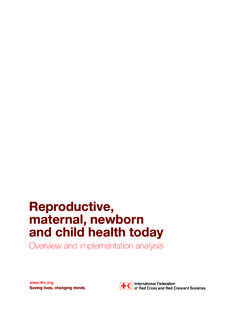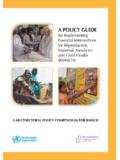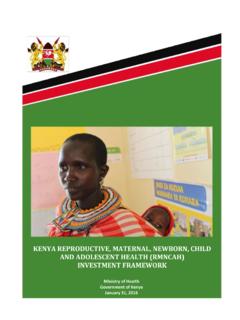Transcription of Maternal and Newborn Health Disparities Zimbabwe
1 ZimbabweMaternal and Newborn Health Disparities UNICEF/UNI144462/Matas2 ZimbabweKey FactsMaternal and Newborn Health Disparities in ZimbabweZimbabwe reference tableDemographic indicatorsTotal population (thousands)1201515,603 Total live births (thousands)12015539 Total Fertility Rate (number of children per woman)120154 Adolescent birth rate (per 1,000 women 15-19)102013120 Impact indicatorsMaternal mortality ratio (per 100,000 live births)42015443 Average annual rate of MMR reduction between 1990 and 2015 (%)520150 Lifetime risk of Maternal death: 1 in x4201552 Stillbirth rate (per 1,000 total births)6201521 Preterm birth rate (per 100 live births)7201017 Under-five mortality rate (per 1,000 live births)3201571 Under-five deaths that are Newborn (%)3201534 Neonatal mortality rate (per 1,000 live births)3201524 Neonatal deaths (thousands)3201513 Service DeliveryAvailability of EmONC Services (% of minimum acceptable level)8 Physician density (per 1,000 population)92 0110.
2 1 Nurse and midwife density (per 1,000 population)92 3 ZimbabweMaternal and Newborn Health DisparitiesIn 2015, 540,000 babies were born in Zimbabwe , or around 1,500 every young women (aged 20-24), 22 percent gave birth by age 35 babies will die each day before reaching their first month3; 31 stillbirths occur every Neonatal mortality rate: Zimbabwe s neonatal mortality rate (NMR)^ is 24 deaths per 1,000 live in rural areas is 32 deaths per 1,000 live births and 27 deaths per 1,000 live births in urban areas for an urban-to-rural ratio of among the poorest households is 32 neonatal deaths per 1,000 live births, compared to 22 deaths per 1,000 live births among the richest mortality rat es, by background characteristics, 2015 Number of neonatal deaths(per 1,000 live births) ,20510152025303540 Mother sEducationMother sAgeHouseholdWealthResidenceRuralPoorest NoeducationHigherRichest32 Urban2722383214 Aged20 34 Aged <202623<20years>20yearsThe NMR for younger mothers (38 per 1,000 live births) is times higher than for mothers aged 20-29 (26 per 1,000 live births).
3 2 Neonatal mortality rat efor newborns with mothers: more likely to die during the first month compared to those born to mothers with higher born to mothers with a primary education are2 in10young women (aged 20-24) have given birth by age ZimbabweHIV/AIDS, diseases, , < NCDs, < , , 1%Injuries, , asphyxiaand birth , Causes of Neonatal Mortality, 2015In Zimbabwe , the main causes of neonatal deaths in 2015 were prematurity ( percent), birth asphyxia ( percent) and sepsis (14 percent).11 Disparities in key Maternal and Newborn Health interventions, Zimbabwe , 20152 Coverage care for mothersCoverage care for newbornsOtherDemand for family planning satisfied by modern methodsAntenatal care coverage at least 4 times (%)aSkilled attendant at birth (%)Institutional delivery (%)Delivered by caesarean section (%)Postnatal care of mother within 2 days (%)Postnatal care of newborns within 2 days (%) Newborn weighed at birth (%)Early initiation of breast-feeding (%)Exclusive breast-feeding (<6 months) (%)BCG vaccine for Newborn (%)DPT1 vaccination received (%)Tetanus protection for newborns (%)Birth registration (%)Births by age 18 (%) a,#Residence Urban8 7.
4 2 . 4 . 4 . ratio (urban to rural) ratio (urban to rural)Household Wealth 2 . wealth ratio (richest to poorest) wealth ratio (richest to poorest)Mother s ageLess than 7. 27 than 20 Mother s s education No educationMother s 3 . 89 4 . s education ratio (highest to lowest) s education ratio (highest to lowest) Zimbabwe 562% of deliveries in the poorest households had a skilled attendantat birth, compared PoorestRichest ..96% of deliveries in the richest and Newborn Health coverage indicators By residence:2 In rural areas, 69 percent of women made at least 4 antenatal care (ANC) visits compared to 72 percent in urban areas. Coverage of skilled attendance at birth is 71 percent in rural areas, compared to 93 percent in urban areas. 71 percent of newborns in rural areas receive postnatal care (PNC) within 2 days after birth, compared to 80 percent in urban household wealth:2 Most mothers among richest households (78 percent) made at least four ANC visits, compared to 65 percent of mothers from the poorest households.
5 Among the poorest households, only 62 percent of deliveries were assisted by a skilled attendant, compared to 96 percent of deliveries in the richest households. 83 percent of newborns in the richest households receive PNC within 2 days after birth, compared to 65 percent among the poorest in key Maternal and Newborn Health interventions, Zimbabwe , 20152 Key for tables: 0-24 % 25-49 % 50-74 % 75 -100% Data not availableCoverage care for mothersCoverage care for newbornsOtherDemand for family planning satisfied by modern methodsAntenatal care coverage at least 4 times (%)aSkilled attendant at birth (%)Institutional delivery (%)Delivered by caesarean section (%)Postnatal care of mother within 2 days (%)Postnatal care of newborns within 2 days (%) Newborn weighed at birth (%)Early initiation of breast-feeding (%)Exclusive breast-feeding (<6 months) (%)BCG vaccine for Newborn (%)DPT1 vaccination received (%)Tetanus protection for newborns (%)Birth registration (%)Births by age 18 (%) a,#Residence Urban8 7.
6 2 . 4 . 4 . ratio (urban to rural) ratio (urban to rural)Household Wealth 2 . wealth ratio (richest to poorest) wealth ratio (richest to poorest)Mother s ageLess than 7. 27 than 20 Mother s s education No educationMother s 3 . 89 4 . s education ratio (highest to lowest) s education ratio (highest to lowest)6 ZimbabweMashonalandCentralMidlandsHarere MashonalandWestBulawayoMashonalandEastMa tebelelandNorthMatebelelandSouthMasvingo ManicalandSkilled attendant at birthPostnatal care of ne wborns within 2 daysEarly initiation of breastfeedingPercent20102030405060708090 1007091956780698184886077837672677080868 74352535657596067768174 Selected Maternal and Newborn Health indicators, by region, 2015By mother s age:2 71 percent of mothers aged 20-34 made at least four ANC visits, compared to 66 percent among younger mothers (aged less than 20).
7 Deliveries among mothers aged 20-34 and younger mothers (aged less than 20) have similar levels of skilled attendance (79 percent and 77 percent, respectively). Newborns born to mothers aged 20-34 and younger mothers (aged less than 20) receive similar levels of postnatal care: 74 percent and 70 percent, in key Maternal and Newborn Health interventions, Zimbabwe , 20152 Coverage care for mothersCoverage care for newbornsOtherDemand for family planning satisfied by modern methodsAntenatal care coverage at least 4 times (%)aSkilled attendant at birth (%)Institutional delivery (%)Delivered by caesarean section (%)Postnatal care of mother within 2 days (%)Postnatal care of newborns within 2 days (%) Newborn weighed at birth (%)Early initiation of breast-feeding (%)Exclusive breast-feeding (<6 months) (%)BCG vaccine for Newborn (%)DPT1 vaccination received (%)Tetanus protection for newborns (%)Birth registration (%)Births by age 18 (%)a,#National 8.
8 17 Central8 7. CentralMashonaland East8 7. 8 . 2 . 6 . EastMashonaland 7. WestMatebeleland 8 . NorthMatebeleland 4 . 7. 3 MasvingoHarere8 597. performanceHighestvalueMashonaland WestManicalandBulawayoHarareBulawayoMata beleland SouthMatabeleland SouthHarareMatabeleland SouthMatabeleland NorthMatabeleland NorthMashonaland WestHarareMashonaland CentralHighestvalueRegional SouthMashonaland CentralMashonaland WestMashonaland WestMashonaland 7. (highest to lowest) (highest to lowest) Zimbabwe 7By mother s education:2 Coverage of tetanus protection for newborns is 38 percent among mothers with no education and nearly 50 percent among mothers with higher education. Only 50 percent of deliveries among mothers with no education were assisted by a skilled attendant, compared to 66 percent of deliveries among mothers with primary education and nearly all deliveries among mothers with higher education.
9 Nearly all newborns born to mothers with higher education are weighed at birth, compared to 60 percent of newborns born to mothers with no geographic regions:2 Manicaland saw the highest rate of antenatal care coverage (at least four visits) of 76 percent, compared to the lowest coverage of 63 percent in Mashonaland Central. The region with the highest coverage of skilled birth attendance is Bulawayo with 95 percent; the lowest coverage is Mashonaland West with 67 percent a difference of times. Matabeleland South has the highest coverage of PNC for newborns (within 2 days after birth) with 87 percent while Manicaland has the lowest coverage at 60 percent a difference of better educated the mother is, themore likely she will receive criticalmaternal Health services50%66%100%PrimaryNoneHigherPerce ntage of deliveries having a skilled birth attendant relative to the education level of the motherKey for tables.
10 0-24 % 25-49 % 50-74 % 75 -100% Data not availableCoverage care for mothersCoverage care for newbornsOtherDemand for family planning satisfied by modern methodsAntenatal care coverage at least 4 times (%)aSkilled attendant at birth (%)Institutional delivery (%)Delivered by caesarean section (%)Postnatal care of mother within 2 days (%)Postnatal care of newborns within 2 days (%) Newborn weighed at birth (%)Early initiation of breast-feeding (%)Exclusive breast-feeding (<6 months) (%)BCG vaccine for Newborn (%)DPT1 vaccination received (%)Tetanus protection for newborns (%)Birth registration (%)Births by age 18 (%)a,#National 8 .17 Central8 7. CentralMashonaland East8 7. 8 . 2 . 6 . EastMashonaland 7. WestMatebeleland 8 . NorthMatebeleland 4 . 7. 3 MasvingoHarere8 597. performanceHighestvalueMashonaland WestManicalandBulawayoHarareBulawayoMata beleland SouthMatabeleland SouthHarareMatabeleland SouthMatabeleland NorthMatabeleland NorthMashonaland WestHarareMashonaland CentralHighestvalueRegional SouthMashonaland CentralMashonaland WestMashonaland WestMashonaland 7.
